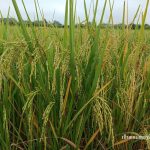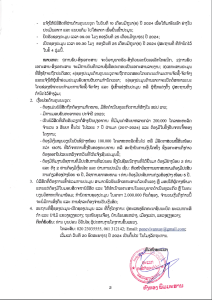ມອບແນວພັນໃໝ່/Give new varieties
ມອບແນວພັນໃໝ່
ປອ ເພັດມະນີແສງ ຊ້າງໄຊຍະສານ
ປະຈຸບັນ ສະພາບແວດລ້ອມ ມີການປ່ຽນແປງ ໄດ້ສົ່ງຜົນກະທົບໂດຍກົງຕໍ່ກັບການຜະລິດເຂົ້າຢູ່ ໃນທົວໂລກ ລວມທັງ ສປປລາວ. ການປ່ຽນແປງຂອງສະພາບແວດລ້ອມ ສົ່ງຜົນໃຫ້ມີການປ່ຽນແປງຂອງປະລິມານນໍ້າຝົນ, ການກະຈ່າຍໂຕຂອງປະລິມານນໍ້າຝົນ ແລະ ຝົນຕົກບໍ່ຖືກຕ້ອງຕາມລະດູການ. ບ່າງປີຝົນຕົ້ກຫຼາຍເກີນໄປ ເຮັດໃຫ້ເກີດນໍ້າຖ້ວມ ແລະ ບາງປີຝົນລະດູຝົນໜ້ອຍ ເຮັດໃຫ້ເກີດໄພແຫ້ງແລ້ງ ເຊິ່ງທັງໝົດ ໄດ້ສົ່ງຜົນກະທົບໂດຍກົງຕໍ່ກັບການຜະລິດເຂົ້າ ຢູ ສປປລາວ. ສປປລາວ ເນື້ອທີ່ຜະລິດເຂົ້າທີ່ອາໃສນໍ້າຝົນກວມເອົາ 88%, ໃນນັ້ນ ເຂດທີ່ມີຄວາມສ່ຽງນໍ້າຖ້ວມກວມເອົາ 20%, ເຂດທີ່ມີຄວາມສຽງກັບໄພແຫ້ງແລ້ງກວມເອົາ 40%, ເຂດທີ່ມີຄວາມສ່ຽງທັງຖ້ວມ ແລະ ແຫ້ງແລ້ງ 30% ເຊິ່ງເຫັນວ່າໃນແຕ່ລະເຂດມີເປັນຂໍ້ຈໍາກົດ ແລະ ກົດໜວງການຜະລິດເຂົ້າ ຢູ ບ້ານເຮົາ ແລະ ເຮັດໃຫ້ຜົນຜະລິດສູນເສຍໃນບາງປີສູງເຖິງ 20%. ໃນປີ 2018, ໄດ້ເກີດໄພແລ້ງ ແລະ ໄພນໍ້າຖ້ວມ ທໍາລາຍເນືອທີ່ການຜະລິດເຂົ້າ 92,255 ເຮັກຕາ ກວມເອົາ 11.8% ຂອງຜົນຜະລິດທັງໝົດ ແລະ ໃນປີ 2019, ເກີດໄພນໍ້າຖ້ວມຢູ 6 ແຂວງພາກກາງທໍາລາຍເນືອທີຮ່ການຜະລິດເຂົ້າ 130,000 ເຮັກຕາ ກວມເອົາ 16.6% ຂອງຜົນຜະລິດເຂົາທັງໝົດ.
ນອກຈາກນີ້ ການລະບາດຂອງພະຍາດເຂົ້າ ກໍ່ເຫັນວ່າມີທ່າອ່ຽງເພີມຂື້ນ ແລະ ມີ່ທ່າອ່ຽງໃນການລະບາດຮ້າຍແຮງຂື້ນ ໂດຍສະເພາະ ແມ່ນການລະບາດຂອງພະຍາດຄໍຮວງເນົ່າ, ພະຍາດໄບໄໝ້ ແລະ ພະຍາດຂອບໃບແຫ້ງ ເປັນຕົ້ນ, ການລະບາດຂອງແມ່ງໄມ້ ສັດຕູພືດ ເຊັ່ນ ເພ້ຍຈັກຈັນສີນໍ້າຕານ ແລະ ເພ້ຍຈັກຈັນສີຂຽວ ກໍ່ມີທ່າອ່ຽງເພີມຂື້ນ ແລະ ຮ້າຍແຮງຂື້ນ ເຊິ່ງທັງພະຍາດ ແລະ ແມງໄມ້ສັດຕູພືດສາມາດສ້າງຜົນເສຍຫາຍໃຫ້ແກ່ຜົນຜະລິດເຂົ້າສູງເຖິງ 10%.
ນອກຈາກນີ້ ບັນຫາໂລກຮ້ອນ ກໍາລັງກາຍເປັນອຸປະສັກທີ່ຈະສົ່ງຜົນກະທົບຕໍ່ກັບການຜະລິດເຂົ້າໃນອານາຄົດ ໂດຍສະເພາະ ຖ້າອຸນນະພູມໂລກເພີມຂື້ນກາຍ 40 ອົງສາເຊ ຈະເຮັດໃຫ້ເຂົ້າປະສົມພັນບໍ່ຕິດ ແລະ ກາຍເປັນໝັນ ເຊິ່ງຈະເຮັດໃຫ້ຜົນຜະລິດເຂົ້າລຸດລົງ, ນັກວິທະຍາສາດ ໄດ້ເຮັດການປະເມີນໄວ້ແລ້ວວ່າ ໃນທຸກ 10 ປີ ອຸນນະພູມໂລກ ຈະເພີມຂື້ນ 1 ອົງສາ ແລະ ການເພີມຂື້ນຂອງອຸນນະພູມໂລກໃນທຸກ 1 ອົງສາເຊ ຈະເຮັດໃຫ້ຜົນຜະລິດເຂົ້າລຸດລົງ 10%, ໝາຍວ່າ ໃນ ອີກ 50 ປີຂ້າງໜ້າ ຄື ປີ 2073 ອຸນນະພູມອາການຈະເພີມຂື້ນ 5 ອົງສາເຊ, ໝາຍວ່າ ໃນປະຈຸບັນ ຖ້າຢູ່ ສປປປລາວ ມີອຸນນະພູມ 40 ອົງສາເຊ ສະນັ້ນ ໃນອີກ 50 ປີຂ້າງໜ້າ ອຸນນະພູມ ຈະເພີມ ເປັນ 45 ອົງສາເຊ ເຊິ່ງຖ້າເປັນໄປຕາມການປະເມິນນີ້ ຜົນຜະລິດເຂົ້າ ຢູ ສປປລາວ ຈະລຸດລົງ 50%.
ເພື່ອແກ້ໄຂບັນຫາ ທີ່ກ່າວມາຂ້າງເທິງນັ້ນ ນັກວິທະຍາສາດ ດ້ານການປັບປຸງ ແລະ ພັດທະນາແນວພັນເຂົ້າ ຂອງສະຖາບັນຄົ້ນຄວ້າກະສິກໍາ, ປ່າໄມ້ ແລະ ພັດທະນາຊົນນະບົດ, ກະຊວງກະສິກໍາ ແລະ ປ່າໄມ້ ສປປລາວ ໄດ້ປະສານສົມທົບກັບ ນັກວິທະຍາສາດ ຈາກສະຖາບັນຄົ້ນຄວ້າສາກົນ ເພື່ອນມິດ ໄດ້ເຮັດການຄົ້ນຄວ້າພັດທະນາແນວພັນເຂົ້າໃໝ່ ທີ່ມີຄວາມສາມາດ ປັບໂຕ ແລະ ທົນທານຕໍ່ກັບການປ່ຽນແປງຂອງສະພາບແວດລ້ອມ ເພື່ອໃຫ້ຊາວນາລາວໄດ້ນໍາໃຊ້ເຂົ້າໃນການຜະລິດ ຮັບປະກັບໄດ້ຜົນຜະລິດເພື່ອການຄໍ້າປະກັນທາງດ້ານສະບຽງອາຫານ ແລະ ຜະລິດເປັນສິນຄ້າ.
ໃນປີ 2023 ນີ້, ນັກວິທະຍາສາດ ດ້ານການຄົ້ນຄວ້າພັດທະນາແນວພັນເຂົ້າຂອງພວກເຮົາ ໄດ້ສໍາເລັດການຄົ້ນຄວ້າພັດທະນາແນວພັນໃໝ່ ແລະ ໄດ້ຈົດທະບຽນເປັນແນວພັນສົ່ງເສີມເປັນສິນຄ້າ ຢູ່ກົມປູກຝັງ ກະຊວງກະສິກໍາ ແລະ ປ່າໄມ້ ເພື່ອໃຫ້ຊາວນາ ແລະ ຜູ້ປະກອບການຜະລິດເຂົ້າເປັນສິນຄ້າ ໄດ້ນໍາໃຊ້ ຢ່າງຖືກກົດໝາຍ. ແນວພັນທີ່ໄດ້ຈົດທະບຽນໃນປີນີ້ ມີ 5 ແນວພັນຄື: ຫອມທ່າດອກຄໍາ 16, ຫອມທ່າດອກຄໍາ 17, ຫອມຫຼວງນໍ້າທາ 2, ຫອມທ່າສະໂນ 13 ແລະ ຫອມໂພນງາມ 7, ທັງໝົດ 5 ແນວພັນນີ້ ມີຄວາມສາມາດທົນທານຕໍ່ກັບນໍ້າຖ້ວມ, ແຫ້ງແລ້ງ, ທົນທານຕໍ່ກັບພະຍາດຄໍຮວງເນົ່າ, ພະຍາດໃບໄໝ້ ແລະ ພະຍາດຂອບໄບແຫ້ງ, ສາມາດປູກໄດ້ທັງນາປີ ແລະ ນາແຊງ, ໄດ້ຜົນຜະລິດສະເລ່ຍ 4-6 ໂຕນ/ເຮັກຕາ, ທີ່ສໍາຄັນມີ ຄວາມຫອມ ແລະ ຄຸນນະພາບໃນການສີ ແລະ ການກິນດີ.
ປະຈຸບັນ ນັກວິທະຍາສາດດ້ານການຄົ້ນຄວ້າພັດທະນາແນວພັນເຂົ້າ ຂອງສະຖາບັນຄົ້ນຄວ້າກະສິກໍາ, ປ່າໄມ້ ແລະ ພັດທະນາຊົນນະບົດ ກໍາລັງສູ່ມໃສການຄົ້ນຄວ້າ ແລະ ພັດທະນາແນວພັນເຂົ້າໃໝ່ ໃຫ້ມີຄວາມສາມາດທົນທານຕໍ່ກັບເພ້ຍຈັກຈັ່ນສີນໍ້າຕານ ແລະ ທົນທານຕໍ່ຄວາມຮ້ອນ ເຊິ່ງຄາດວ່າຈະມີແນວພັນໃໝ່ ອອກສູ່ການຜະລິດພາຍໃນອານາຄົດອັນໃກ້ນີ.
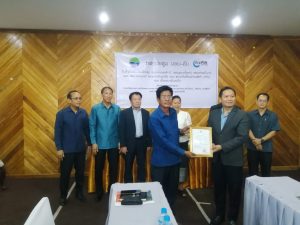
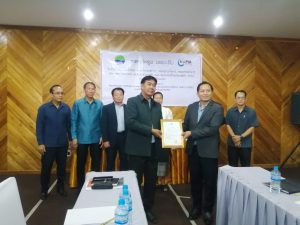
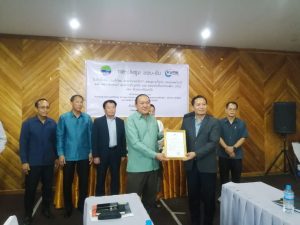
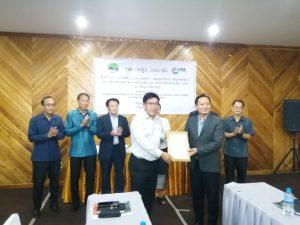
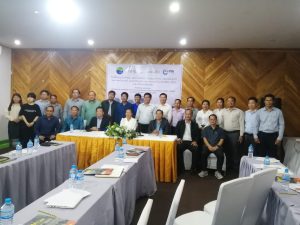
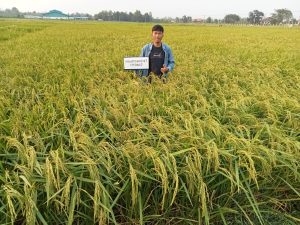
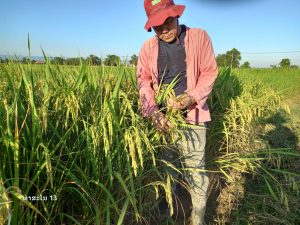
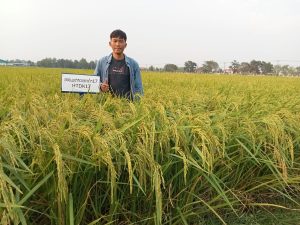
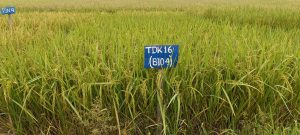
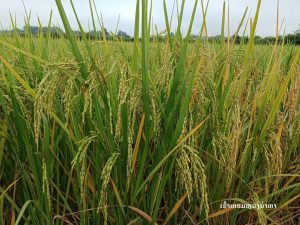
Dr Phetmanyseng Xangsayasane
Currently, the changing environment has directly affected rice production in the world, including Lao PDR. Changes in the environment result in changes in the amount of rainfall, the distribution of rainfall and irregular rainfall. Some years of excessive rainfall cause floods and some years of low rainfall cause drought, all of which directly affect rice production in Lao PDR.
Lao PDR’s rice production area covers 88%, of which the flood-prone area covers 20%, the drought-prone area covers 40%, the flood- and drought-prone area covers 30%. It is seen that in each area there is limitation to produce rice and cause yield loss in some years is up to 20%.
In 2018, drought and floods destroyed 92,255 hectares of rice production, accounting for 11.8% of the total production, and in 2019, floods occurred in 6 provinces in the central region, destroying 130,000 hectares of rice production, accounting for 16.6% of the total production.
In addition, the epidemic of rice diseases is seen to be on the rise and there is a tendency to become more serious, especially the outbreak of the disease of the neck blast, bacterial leaf blight and blast disease, etc., the epidemic of insects and pests such as the brown plant hopper and the green leaf hopper are also increasing significantly. Both diseases and insect pest can damage the yield of rice up to 10%.
In addition, global warming is becoming an obstacle that will affect production in the future, especially if the global temperature rises above 40 degrees, it will affect to yield loss due to loss hybridization. It is estimate that every 10 years, world temperature is increase 1 degree and it means that in the next 50 years (in 2073), the temperature will increase by 5 degrees and if current temperature in Lao PDR is 40 degrees, so in the next 50 years, the temperature will increase to 45 degrees this will affect to rice production loss in Laos up to 50%.
In order to solve the problem mentioned above, the rice scientists from NAFRI, Ministry of Agriculture and Forestry, Lao PDR who work on rice breeding program have collaborate with scientists from international research institutes to research and develop climate resilience rice varieties that can cope with climate change.
In the year 2023, Rice scientists from NAFRI have completed in development the 5 new climate resilience rice varieties and have been registered as commercial rice varieties with Department of Agriculture, Ministry of Agriculture and Forestry, so that farmers and commercial rice producers can use it legally. The varieties registered this year are 5 varieties: HTDK16, HTDK17, HLNT2, HTSN13, and HPNG7. All these 5 varieties have the ability to tolerant to floods, droughts, bacterial leaf blight and blast disease. They can be grown both dry and wet season, yielding an average of 4-6 tons/hectare, fragrance and good eating and milling quality.
Currently, rice scientists from NAFRI are researching and developing new rice varieties with the ability to be resistant to brown plant hopper and tolerance to heat, which is expected to release as new varieties in the near future.
